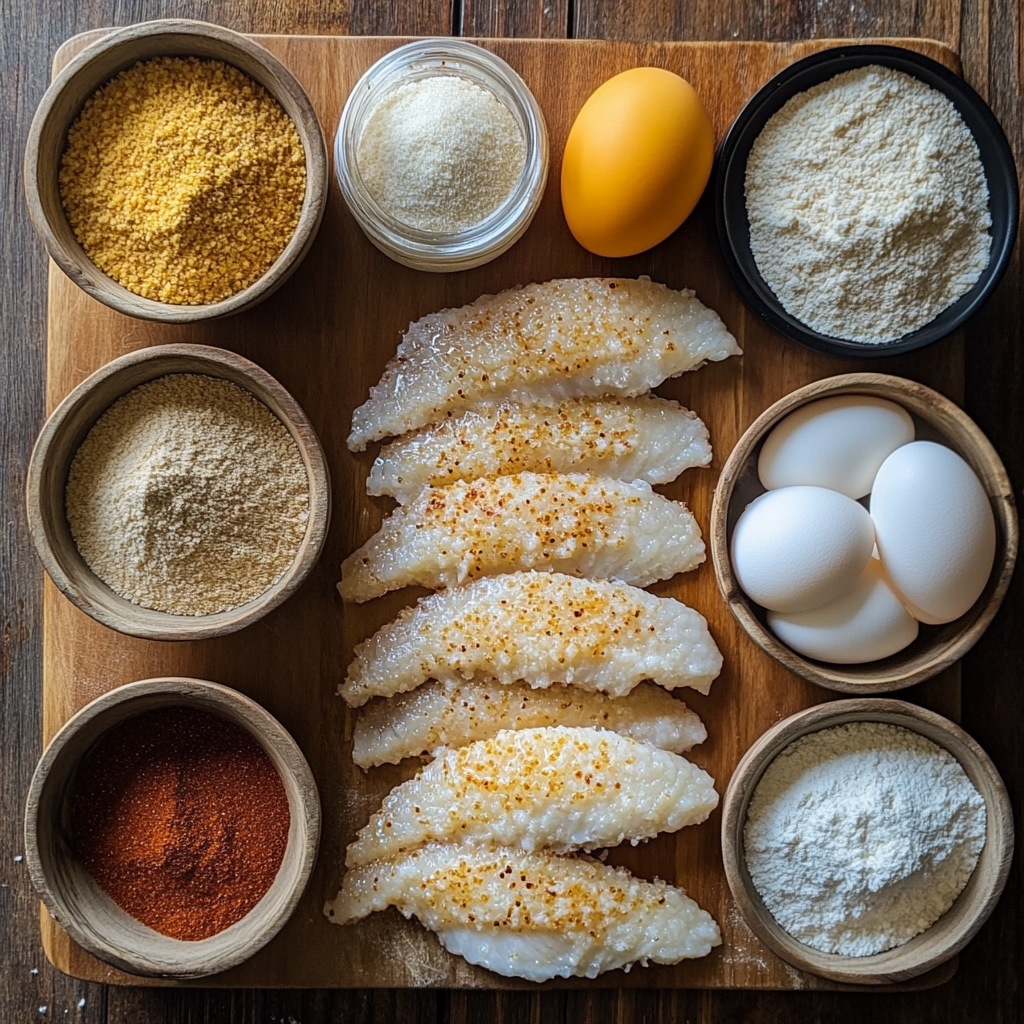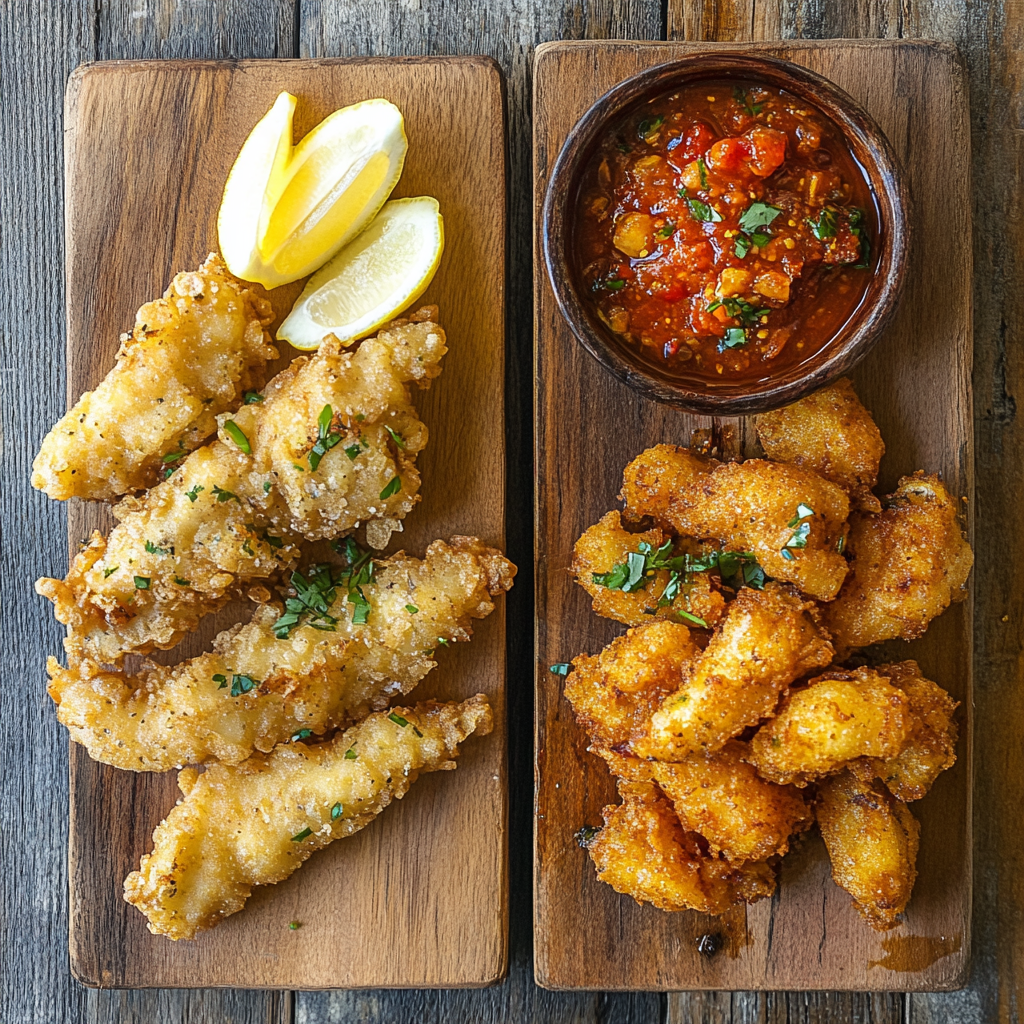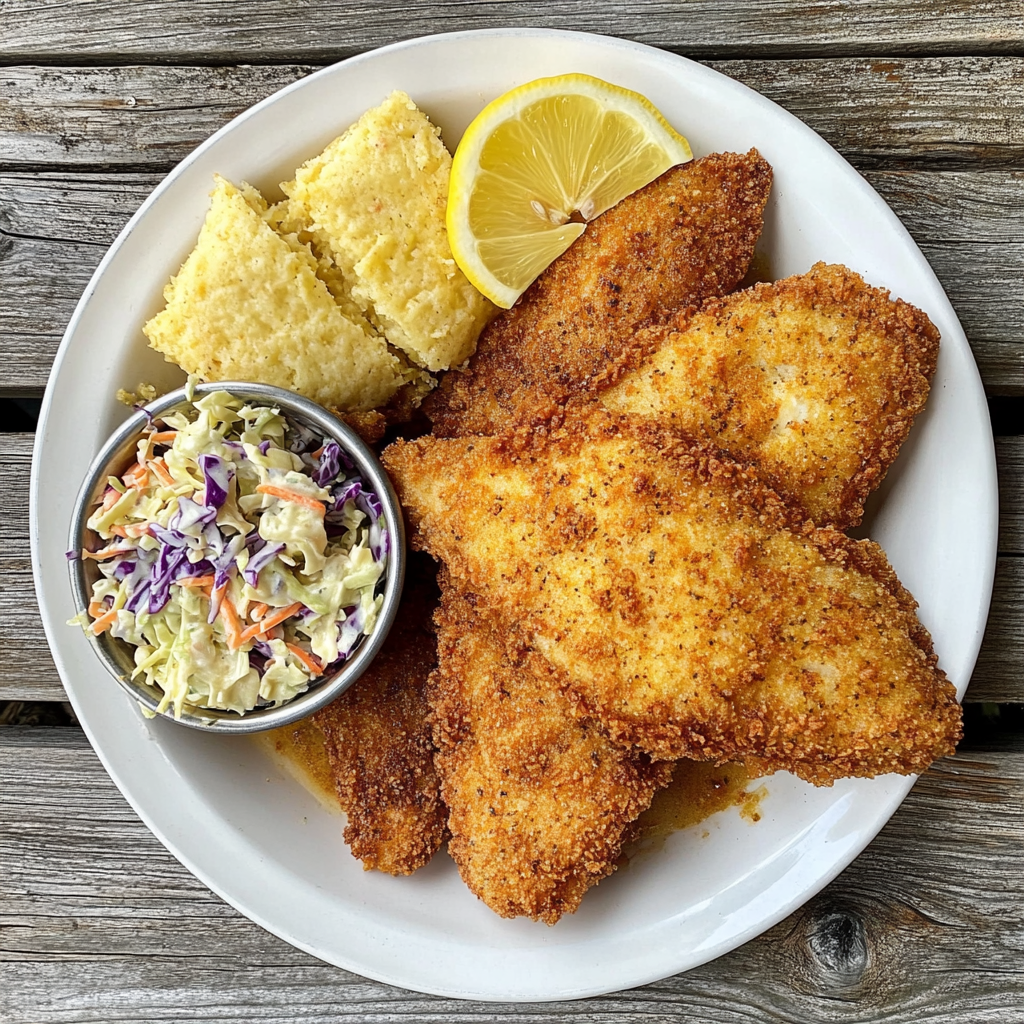Are you on the lookout for a perfectly crispy fried crappie recipe that combines ease of preparation with a fantastic flavor? Whether you’re a seasoned cook or a beginner, this recipe is bound to elevate your cooking game. Crappie, a mild-tasting white fish, lends itself beautifully to frying, and with a few basic ingredients like vegetable oil, cornmeal, and seasonings, you can whip up a dish that is both mouth-watering and family-friendly.
This recipe works wonderfully for casual dinners, family gatherings, or even outdoor picnics after a successful fishing trip. It’s also versatile enough to suit different dietary preferences by making simple adjustments. You’ll love how crispy fried crappie pairs with a variety of sides, from coleslaw to hush puppies, and fits right into your favorite meal rotation—whether it’s lunch, dinner, or even a hearty snack. If you’re curious about more fried treats, be sure to explore our snacks section for complementary recipes that make every meal memorable!
Comprehensive Ingredients Overview for Crispy Fried Crappie Recipe
The ingredients for this crispy fried crappie recipe are straightforward and accessible, but what really makes the magic happen is how they combine to create the perfect texture and flavor. Crappie fish, with its light, delicate flesh, needs a coating that enhances its taste while delivering the right amount of crunch. Let’s break down the essential ingredients, along with possible substitutions to cater to different dietary preferences:
Primary Ingredients for a Perfect Crappie Fry:
- Fresh crappie fillets: The key to this recipe’s success is the quality of the fish. If you have access to fresh crappie, that’s ideal, but frozen crappie fillets work just as well when properly thawed. Crappie’s mild, flaky texture is perfect for frying. Can’t find crappie? Substitute with other white fish like catfish, tilapia, or perch, which also have a subtle flavor and flake nicely when fried.
- Cornmeal: This is the star of the batter! Cornmeal gives the fried crappie its signature crunch. Opt for fine yellow cornmeal for the best results. For a gluten-free version, make sure to check that your cornmeal is certified gluten-free, as some varieties may be cross-contaminated.
- All-purpose flour: Flour adds a layer of crispiness and helps the cornmeal adhere to the fish. You can mix regular flour with almond flour or coconut flour for a lower-carb alternative. The combination of flour and cornmeal is what makes the coating light but substantial.
- Vegetable oil: When it comes to frying, vegetable oil is your best friend. It has a neutral flavor and a high smoke point, which means it can handle the high heat required for frying without burning or imparting any undesirable flavors to your fish. Alternatives include canola oil or sunflower oil, but avoid oils like olive oil that can smoke too quickly.
- Eggs: Eggs play a crucial role as the binding agent that helps the cornmeal coating stick to the fish. If you’re following a vegan diet, you can replace eggs with a flaxseed or chia seed mixture (1 tablespoon of flaxseed or chia seeds mixed with 3 tablespoons of water, let sit for 10 minutes).
- Seasonings: The right blend of seasonings can take your fried crappie from good to unforgettable. This recipe calls for a basic but flavorful mix of salt, pepper, paprika, and garlic powder. If you’re feeling adventurous, try adding a pinch of cayenne for heat or lemon pepper for a citrusy zing.
Dietary Substitutions:
- Gluten-free: Substitute the flour with a gluten-free blend and ensure your cornmeal is gluten-free.
- Vegan: Replace the eggs with a flaxseed or chia seed mixture and choose a plant-based flour like chickpea or rice flour.
If you’re a fan of crunchy and crispy fried snacks, don’t miss out on our snacks section, where you’ll find similar recipes that will satisfy your craving for fried goodness!

Essential Tools Needed for the Best Fried Crappie
Preparing the best crispy fried crappie doesn’t require an advanced kitchen setup. With just a few essential tools and a little know-how, you can create a mouthwatering fish fry that rivals any restaurant version. Let’s dive into the equipment you’ll need and some useful alternatives to help you achieve crispy perfection without any fuss.
Must-Have Tools:
- Deep fryer or cast-iron skillet: While a deep fryer ensures an even, golden fry every time, a cast-iron skillet works just as well. The cast-iron skillet is especially effective because it retains heat consistently, which is key for frying. A heavy-bottomed Dutch oven can also work in a pinch.
- Vegetable oil: You’ll need a good amount of vegetable oil to fry the fish to perfection. It’s important to use enough oil to fully submerge the fillets or at least ensure they’re covered halfway when using a skillet. A deep fryer makes it easy to monitor oil levels and frying temperatures.
- Tongs: Frying fish can be a delicate process. Tongs allow you to gently flip the crappie fillets without breaking them apart. If you don’t have tongs, a slotted spatula can work as well, but be gentle!
- Wire rack or paper towels: After frying, it’s essential to drain the crappie properly to keep it crispy. A wire rack allows the excess oil to drip off, ensuring the fish stays crunchy. If you don’t have a rack, paper towels work well to absorb extra oil.
- Mixing bowls: You’ll need at least two mixing bowls—one for the egg wash and one for the cornmeal and flour mixture. Having larger bowls makes the coating process much easier and cleaner.
- Thermometer (optional but recommended): Keeping the oil at the right temperature (around 350°F to 375°F) is key to achieving a crispy, golden exterior without burning the fish or leaving it undercooked. A simple kitchen thermometer can help you monitor the oil’s heat and ensure your fish is frying to perfection.
Tool Substitutions:
- No deep fryer? No problem! You can use any large pot for frying. Just make sure the oil is deep enough to submerge the fish halfway.
- If you don’t have a wire rack, let the fish sit on paper towels to drain any excess oil.
For more recipe ideas that use similar kitchen tools, check out our Dinner section, where you’ll find a variety of dishes that also rely on frying techniques.
Step-by-Step Instructions for Perfect Crispy Fried Crappie Recipe
One of the best things about this crispy fried crappie recipe is how simple it is to follow. With a few easy steps, you can create a delicious fish fry that’s perfect for any occasion. Each step is designed to ensure that even beginners can successfully fry crappie to crispy, golden perfection. Let’s break it down:
Step 1: Prep the Crappie Fillets
Start by thoroughly rinsing your crappie fillets under cold water to remove any lingering scales or debris. After rinsing, pat the fillets completely dry with paper towels. This step is crucial because excess moisture on the fish can prevent the batter from sticking properly and may cause the oil to splatter during frying.
Step 2: Prepare the Breading Station
Set up your breading station by preparing two mixing bowls. In the first bowl, whisk the eggs until smooth. In the second bowl, mix together the cornmeal, flour, salt, pepper, paprika, and garlic powder. The combination of cornmeal and flour will provide the ideal balance of crunch and flavor. Make sure the seasoning is evenly distributed throughout the flour and cornmeal mixture for consistent flavor in every bite.
Step 3: Coat the Crappie Fillets
Working with one fillet at a time, dip the crappie fillet into the egg mixture, ensuring it’s fully coated on both sides. Then, immediately transfer it to the cornmeal-flour mixture, pressing down gently to make sure the coating sticks. Repeat this process for all fillets. The key here is to coat the fish evenly to create a crispy, well-seasoned crust when frying.
Step 4: Heat the Vegetable Oil
Pour vegetable oil into your skillet or deep fryer, making sure it’s deep enough to submerge at least half of the fish. Heat the oil to 350°F to 375°F. If you don’t have a thermometer, you can test the oil by dropping a small pinch of the cornmeal mixture into the pan. If it sizzles immediately, the oil is ready for frying. Using vegetable oil ensures a neutral flavor and allows the fish’s natural flavors to shine.
Step 5: Fry the Crappie Fillets
Once the oil has reached the proper temperature, carefully place the breaded crappie fillets into the hot oil. Fry the fillets for about 3-4 minutes on each side or until they turn a golden-brown color. Use tongs to flip the fillets gently, being careful not to overcrowd the pan, as this can lower the oil temperature and result in soggy fish. Fry in batches if necessary.
Step 6: Drain and Serve
After the fillets are fried to golden perfection, transfer them to a wire rack or a plate lined with paper towels to drain off any excess oil. This step is important to ensure the fish remains crispy. Once drained, serve your crispy fried crappie immediately for the best texture and flavor.
For more step-by-step instructions using similar frying methods, take a look at our Breakfast section, where we explore frying techniques with other tasty recipes.
Flavor Variations to Customize Your Fried Crappie Recipe
One of the most appealing aspects of this crispy fried crappie recipe is how easily it can be adapted to suit different flavor preferences. Whether you’re looking for a spicy kick, a light and refreshing twist, or a completely plant-based version, there are plenty of ways to customize this dish. Here are some flavor variations that will elevate your fried crappie to the next level:
Lemon Herb Crappie:
For a lighter, fresher version of this dish, try adding lemon zest and freshly chopped herbs to your cornmeal mixture. Herbs like parsley, thyme, or dill work wonderfully with the mild flavor of crappie. The lemon zest adds a pop of brightness that balances out the richness of the fried fish. Serve with a side of lemon wedges for an extra citrusy kick.
Spicy Cajun Crappie:
If you’re in the mood for something with more heat, add some Cajun seasoning to your cornmeal mix. You can also sprinkle cayenne pepper or smoked paprika for an added depth of flavor. To take it even further, drizzle your fried crappie with hot sauce or serve it alongside a spicy remoulade. This variation pairs perfectly with sides like coleslaw or corn on the cob.
Vegan Crappie:
For a plant-based twist, substitute the eggs in the batter with a flaxseed or chia seed mixture. Use a gluten-free flour like chickpea flour, and opt for plant-based oils like sunflower oil. Serve this version with a vegan aioli or a squeeze of fresh lemon juice for a healthy and satisfying meal that doesn’t compromise on flavor.
For more creative pairings and side dish ideas, take a look at our snacks section, where we offer delicious sides to accompany your fried crappie.

Expert Tips for Making the Best Crispy Fried Crappie
Mastering the art of frying crappie is easy with a few expert tips. By following these tried-and-true methods, you’ll achieve a crispy, flavorful fish fry every time. Here’s how to avoid common mistakes and make sure your crispy fried crappie comes out perfect with each attempt:
Tip 1: Always Pat the Fish Dry
One of the biggest mistakes people make when frying fish is not properly drying the fillets before coating them. If the fillets are wet, the coating won’t stick as well, and you’ll end up with soggy, unevenly fried fish. Take the time to thoroughly pat each fillet dry with paper towels before moving on to the breading process.
Tip 2: Don’t Overcrowd the Pan
Frying too many fillets at once can cause the oil temperature to drop, resulting in greasy, soggy fish. It’s better to fry in small batches to maintain a consistent oil temperature of 350°F to 375°F. This ensures that each fillet cooks evenly and develops a crispy, golden exterior.
Tip 3: Use the Right Oil
Using the right oil is essential to getting a perfect fry. Vegetable oil is ideal because it has a high smoke point and a neutral flavor that won’t overpower the fish. Avoid using oils with a low smoke point, like olive oil, as they can burn quickly and affect the taste of the fish.
For more expert frying tips, check out our Dinner section, where similar techniques are used in other fried recipes.
Nutritional Information for Fried Crappie
Despite being fried, this crispy fried crappie recipe can still fit into a balanced diet. Crappie itself is a lean, low-calorie fish that’s high in protein and offers a variety of health benefits. Here’s a quick overview of the nutritional value of this dish:
- Calories: Approximately 250-350 calories per serving, depending on the size of the fillets and the amount of oil absorbed during frying. Using vegetable oil helps to minimize unhealthy fats compared to some alternatives.
- Protein: Crappie is rich in lean protein, providing around 20-25 grams per serving, which is great for muscle repair and overall health.
- Omega-3 fatty acids: Like many fish, crappie is a source of omega-3s, which promote heart health and reduce inflammation.
- Carbohydrates: The cornmeal and flour mixture adds a modest amount of carbs, making this dish filling without being overly heavy.
For more in-depth nutritional information, visit this health blog to explore the benefits of eating lean fish like crappie.
Serving Suggestions for Fried Crappie
To complete your meal, consider pairing your crispy fried crappie with some tasty sides and refreshing drinks. Here are some classic combinations that will complement the flavors and textures of this dish:
Classic Southern Pairings:
- Coleslaw: The crunch and tanginess of coleslaw make it the perfect side for fried fish. The cool, creamy texture balances out the heat and crispiness of the crappie.
- Cornbread: A traditional Southern side, cornbread adds a comforting, slightly sweet flavor that pairs beautifully with the savory, crispy fish.
- French Fries: You can’t go wrong with crispy fries as a side for your crappie. Serve them with a dipping sauce like tartar or ketchup for a classic fish fry experience.
- Lemon wedges: A squeeze of lemon over your fried crappie adds brightness and cuts through the richness of the fried coating, enhancing the overall flavor.
Looking for more side dish ideas to pair with this meal? Check out our Dinner section for a variety of dishes that complement fried fish.

Storage Tips for Leftover Fried Crappie
If you happen to have leftovers, don’t worry! Properly storing and reheating your crispy fried crappie can help preserve its flavor and crunch. Here are some tips for keeping your fried fish fresh:
Refrigeration:
Store leftover crappie in an airtight container in the fridge for up to 2 days. When reheating, avoid using the microwave, as it can make the fish soggy. Instead, reheat the crappie in a 350°F oven for 10-12 minutes, or until it regains its crispiness.
Freezing:
You can also freeze fried crappie for up to 1 month. To freeze, place the fillets in a single layer on a baking sheet and freeze until solid. Once frozen, transfer the fillets to a freezer-safe container. When ready to eat, bake the fillets from frozen at 375°F for about 15-20 minutes.
FAQs About Crispy Fried Crappie
What’s the best way to cook fresh-caught crappie fish?
The best way to cook fresh-caught crappie is to fry it with a simple cornmeal coating, as outlined in this recipe. Frying highlights the fish’s delicate flavor while creating a crispy, satisfying texture. For more cooking methods, check out our Dinner section.
What is a good crispy fish fry recipe?
A good crispy fish fry recipe starts with fresh fillets, a well-seasoned cornmeal coating, and the right frying temperature. Follow the steps in this recipe for consistently delicious results. Don’t forget to use vegetable oil to achieve that perfect golden-brown crust!
Conclusion: Why You Should Try This Crispy Fried Crappie Recipe
This crispy fried crappie recipe is a simple yet delicious way to enjoy one of the most popular freshwater fish. With its golden, crunchy coating and tender, flaky interior, it’s a meal that’s sure to please everyone at the table. Whether you’re hosting a fish fry, cooking for your family, or treating yourself after a successful day of fishing, this recipe is a must-try.
